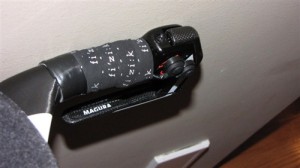| Note: This is a guest post from one of our Members, John Withrow. This is a sample of the great resources and content our members provide one another in addition to the coaching, training plans and race day support and resources. Enjoy! |
 I recently got a P5 with Di2. The brakes are Magura Hydraulic which are very nice. BUT, in their rush to get this bike out the door, Cervelo launched it without shifters on the bull horns. I kind thought this was one of the main benefits of having Di2 on a TT bike, so I decided to take matters into my own hands.
I recently got a P5 with Di2. The brakes are Magura Hydraulic which are very nice. BUT, in their rush to get this bike out the door, Cervelo launched it without shifters on the bull horns. I kind thought this was one of the main benefits of having Di2 on a TT bike, so I decided to take matters into my own hands.
I bought 2 sets of these Cateye remote buttons for $9 each: http://tinyurl.com/8okd3u3
First thing I did was take out my Di2 battery. Don’t know if this is necessary or not, but better safe than sorry.
Then tried for a while to find the “male” connector to tie directly into the Di2 TT wiring kit. After not being able to find them for sale anywhere and not really wanting to put the effort into making my own custom connector, I took out my side snips and simple cut the connector off. There are 4 tiny wires inside the main wire (Red, Black, Green, Blue):
One of the hardest things was actually getting the Di2 Wire out through the bars to the bull horns. It took me at least 15-20 minutes of fiddling with a strong wire to fish it through to act as a snake. The space is very small through the base bars and it is already mostly filled with the hydraulic brake line which doesn’t really move at all.
Once I got the snake through it was time to start splicing wires. I know splicing wasn’t ideal because I basically can’t take my bars off without cutting the work I just did. But I was a bit time constrained and at this point I mostly have my fit dialed in, so I figured it was worth the gamble. If I find some tiny 3 wire connectors, maybe I have a mid-winter project to make this better…
There are 4 Di2 wires and each of the Cateye only has one main wire and a ground. After a bit of research I learned that the blue Di2 wire is not used for TT setups. So for wiring it was Red (from Cateye button) to Red (Di2). White (from other Cateye button) to Black (Di2). Then twist the 2 bare wires (from the Cateye buttons) and attach them to the Green (Di2)
I first slid heat shrink onto the wires, then twisted the wires, then soldered them, then slid the heat-shrink over the bare parts and heated to shrink on for insulation. (This is less important on the green, but still did it when I did the other side.
Then I used heat-shrink on the whole thing.
Then for good measure, I taped it very tightly with electrical tape, then used my torch to melt the tape to hopefully have a nice, tight, waterproof seal.
Now I pulled the wires back into the base bar and creaamed the rest of the rat’s nest of wires down inside the bars and remounted the cap.
Next step was to mount the buttons (they simply stick onto the side of the Magura brake levers). The buttons are numbered and with a little trial-and-error, I figured out which one was upshift and which was downshift. I oriented them such that the downshift was the same as they are out at the end of the bars (which I think is on top). Then I retaped my bars and voila, shifters on the bullhorns.
Below is my whole front end setup now. Couple of things I did that are unusual. To have the straw of my Speedfil A2 be in the right spot, I mounted the cage mount facing backwards, but put the bottle in backwards on the cage. I also needed to raise the front of the bottle just a little bit, so I made a spacer (~1cm) out of a small piece of the aerobar extensions that I had cut-off during the fitting. This allows the water to naturally fall to the back where the end of the straw is. I also couldn’t find a Garmin mount I liked, so I wook and old aluminum broom stick and cut a few inch section, then used a grinder to hollow out the sides so it fits perfectly against the aero bar extensions. I drilled a couple of holes to keep it snug with a pair of zip ties.
While I’m at it here is my rear bottle holder:
And Jess thought I was CRAZY for putting stickers all over my new bike, but… I figured it was fitting to have the EN stickers near my cranks, because EN helped build the legs that will be turning those cranks. Another interesting note is that the mechanics at my LBS were all geeked out because they said that they did “the impossible”. They got my GXP SRM to fit on this P5 (with BBRight bottom bracket). Apparently, a nowmal pressfit GXP adapter will not work on a P5. They had to take apart a couple of different bottom brackets and use the bearings from a Shimano BB on one side and a different set ont he other side. All said and done, my bike is now GXP compatible and holds the SRM great. The ReserveAid stickers are for my Charity team www.reserveaid.org/TeamRA
Summary:
I rode it one time outside for a couple of hours this weekend with these new shifters and what a dream! It was so nice having them right there on the bull horns. It was especially nice if I was coming up to an intersection or when climbing. I found it effortless and much more stable to be able to shift without letting go of the horns. I actually find myself shifting a lot more with the Di2 which allows my cadence to be much more stable.




ANGELO
Great job.
In your splicing, I missed the part where you spliced the wires from the DI2 shifters on the aero bar to the “rat’s nest of wires”. Is this not necessary?